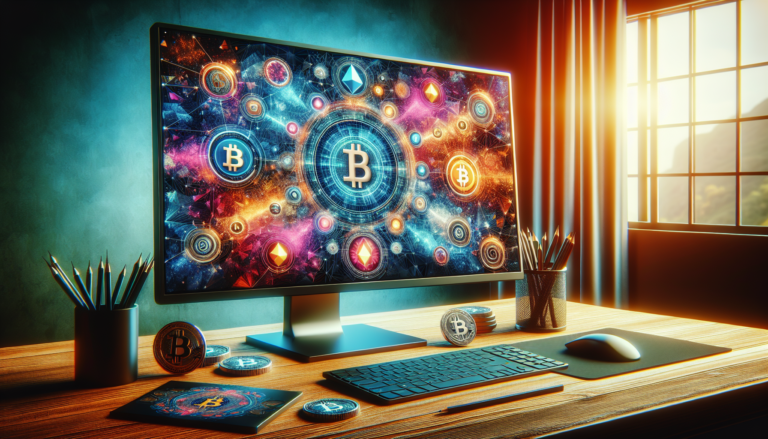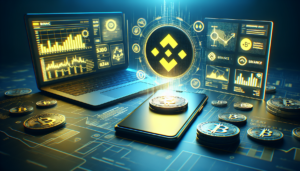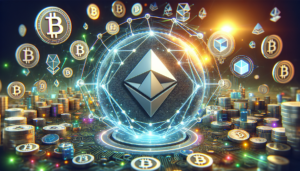Non-Fungible Tokens (NFTs) have taken the digital world by storm, revolutionizing the way we think about ownership and value in the digital space. NFTs are unique digital assets that represent ownership of a specific item or piece of content, verified through blockchain technology. In this article, we’ll dive into the world of NFTs, explaining what they are, how they work, and their potential applications.
Introduction to NFTs: What Is NFT Mean?
Definition of NFTs
NFTs, or Non-Fungible Tokens, are digital assets that are unique and cannot be exchanged on a one-to-one basis. Unlike cryptocurrencies such as Bitcoin or Ethereum, where each unit is identical and interchangeable, NFTs represent ownership of a specific digital item, such as artwork, music, or even virtual real estate. This uniqueness is what gives NFTs their value and sets them apart from other digital assets.
The term “non-fungible” refers to the fact that each NFT is distinct and cannot be replaced by another identical item. For example, while one Bitcoin can be exchanged for another Bitcoin without any loss of value, an NFT representing a specific digital artwork cannot be replaced by another NFT, even if it represents a similar artwork.
How NFTs Differ from Cryptocurrencies
Although NFTs and cryptocurrencies both utilize blockchain technology, they serve different purposes. Cryptocurrencies are designed to be fungible, meaning that each unit is identical and can be exchanged for another unit of equal value. They are primarily used as a medium of exchange or store of value.
On the other hand, NFTs are non-fungible, representing unique digital assets. They are not meant to be used as a currency but rather as a way to establish ownership and provenance of digital items. While cryptocurrencies are divisible into smaller units, NFTs are indivisible and represent a single, unique asset.
The Technology Behind NFTs: Blockchain Explained
Role of Blockchain in NFTs
Blockchain technology plays a crucial role in the creation, ownership, and transfer of NFTs. A blockchain is a decentralized, digital ledger that records transactions across a network of computers. When an NFT is created, or “minted,” it is assigned a unique digital signature that is stored on the blockchain.
This digital signature serves as proof of ownership and authenticity, allowing anyone to verify the origin and history of the NFT. The blockchain ensures that the ownership and transfer of NFTs are transparent, secure, and tamper-proof. It also enables artists and creators to have control over their digital assets and receive proper recognition and compensation for their work.
Ethereum and Smart Contracts
Ethereum, a decentralized blockchain platform, has emerged as the primary platform for creating and trading NFTs. Ethereum’s smart contract functionality allows for the creation of unique digital assets and the automation of NFT transactions.
Smart contracts are self-executing contracts with the terms of the agreement directly written into code. They enable the automatic transfer of ownership and ensure that the conditions of the NFT sale are met without the need for intermediaries. Ethereum’s ERC-721 and ERC-1155 standards have become the most widely used protocols for NFT creation and management.
Applications of NFTs
NFTs in Art and Music
One of the most prominent applications of NFTs is in the art world. Artists can create digital artworks and sell them as NFTs, providing a new medium for creative expression and monetization. NFTs allow artists to establish provenance, prove authenticity, and receive fair compensation for their digital creations.
In the music industry, NFTs are being used to sell unique digital content, such as limited-edition albums, exclusive concert tickets, or even virtual experiences with artists. Musicians can also use NFTs to offer fractional ownership of their songs or albums, allowing fans to invest in and support their favorite artists directly.
NFTs in Gaming and Virtual Real Estate
NFTs have found significant applications in the gaming industry, particularly in blockchain-based games. In-game items, such as weapons, skins, or characters, can be represented as NFTs, allowing players to own, trade, and sell these digital assets. This creates a new level of ownership and value within gaming ecosystems.
Virtual real estate is another area where NFTs are making an impact. Platforms like Decentraland and The Sandbox allow users to purchase virtual land parcels as NFTs. These virtual properties can be developed, rented, or sold, creating a new market for digital real estate.
NFT Marketplaces: Where to Buy and Sell NFTs
Popular NFT Marketplaces
NFT marketplaces have emerged as the primary platforms for buying, selling, and trading NFTs. These marketplaces provide a space for creators to showcase their digital assets and for collectors to discover and acquire unique NFTs. Some of the most popular NFT marketplaces include:
- OpenSea: OpenSea is one of the largest and most diverse NFT marketplaces, offering a wide range of digital assets, including art, collectibles, and gaming items.
- Foundation: Foundation focuses on high-quality digital art, curating a selection of artists and their unique creations.
- SuperRare: SuperRare is an exclusive marketplace that emphasizes scarcity and originality in digital art, featuring a limited number of hand-picked artists.
How to Buy and Sell NFTs
To buy or sell NFTs, you’ll need to have a digital wallet that supports the blockchain platform on which the NFT is built, such as Ethereum. You’ll also need to have the necessary cryptocurrency, such as Ether (ETH), to complete the transaction.
On NFT marketplaces, you can browse through the available NFTs, view their details, and make a purchase using the marketplace’s built-in wallet or by connecting your own digital wallet. When selling an NFT, you’ll need to “mint” your digital asset, which involves creating a unique token on the blockchain and listing it for sale on the marketplace.
Understanding NFT Ownership and Revenue
Ownership and Provenance
One of the key benefits of NFTs is the ability to establish clear ownership and provenance of digital assets. When you purchase an NFT, you are acquiring a unique token that represents ownership of that specific digital item. This ownership is recorded on the blockchain, providing a transparent and immutable record of the NFT’s history and authenticity.
However, it’s important to note that owning an NFT does not necessarily grant you ownership of the underlying intellectual property or copyright. The specific rights and permissions associated with an NFT can vary depending on the terms set by the creator or the platform on which it is sold.
Revenue and Royalties for Artists
NFTs provide a new revenue stream for artists and creators, allowing them to monetize their digital creations directly. When an artist sells an NFT, they can set their own price and receive payment in cryptocurrency. Additionally, many NFT platforms allow artists to set royalty percentages, ensuring that they receive a portion of the proceeds each time their NFT is resold on the secondary market.
This royalty model provides ongoing revenue for artists, even after the initial sale of their NFT. It also incentivizes creators to continue producing high-quality digital content, as they can benefit from the appreciation of their works over time.
Criticism and Challenges of NFTs
Environmental Impact
One of the main criticisms of NFTs is their potential environmental impact. The creation and transfer of NFTs rely on blockchain technology, which requires significant computational power and energy consumption. The energy-intensive process of mining and validating transactions on the Ethereum blockchain has raised concerns about the carbon footprint associated with NFTs.
However, efforts are being made to address this issue, such as the transition to more energy-efficient blockchain networks and the development of eco-friendly NFT platforms. As the NFT market evolves, it is important to consider and address the environmental implications to ensure a sustainable future for digital assets.
Market Speculation and Scams
The rapid growth and popularity of NFTs have also led to market speculation and the emergence of scams. Some critics argue that the NFT market is driven by hype and that the high prices paid for certain NFTs may not reflect their long-term value.
Additionally, the NFT space has seen instances of fraud, such as counterfeit NFTs, plagiarism, and misrepresentation of ownership. It is crucial for buyers to exercise caution, conduct thorough research, and only purchase NFTs from reputable sources to avoid falling victim to scams.
The Future of NFTs
Potential Developments
The NFT market is still in its early stages, and there is significant potential for growth and innovation. As blockchain technology advances and becomes more accessible, we can expect to see new applications and use cases for NFTs emerge.
Some potential developments include the integration of NFTs with augmented and virtual reality, the use of NFTs for digital identity and certification, and the expansion of NFTs into new industries, such as real estate, education, and healthcare. The possibilities are vast, and the future of NFTs is likely to be shaped by the creativity and ingenuity of developers, artists, and entrepreneurs.
Long-term Value and Sustainability
As the NFT market matures, questions arise about the long-term value and sustainability of these digital assets. While some NFTs have sold for millions of dollars, it remains to be seen whether these prices will hold up over time.
To ensure the longevity and value of NFTs, it is important to focus on creating digital assets with intrinsic value, utility, and cultural significance. NFTs that offer unique experiences, solve real-world problems, or represent meaningful cultural artifacts are more likely to maintain their value in the long run.
Additionally, the sustainability of the NFT market will depend on addressing the environmental concerns, ensuring fair compensation for creators, and fostering a community of engaged and informed participants.
In conclusion, NFTs represent a paradigm shift in the way we think about digital ownership and value. By leveraging blockchain technology, NFTs provide a means to establish authenticity, provenance, and scarcity in the digital realm. As the NFT market continues to evolve, it is important to approach this exciting new frontier with a mix of enthusiasm, caution, and a commitment to building a sustainable and equitable ecosystem for creators and collectors alike.
See also:
- What Does NFT Mean? Understanding Non-Fungible Tokens Explained
- What Is an NFT Art? Understanding Non-Fungible Tokens in the Art World
- What Is NFT Crypto? Understanding Non-Fungible Tokens
- How to Sell NFT: A Step-by-Step Guide for Beginners
- What Does It Mean to Mint an NFT? Understanding the Process






